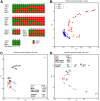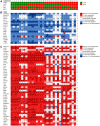Analysis of the effects of five factors relevant to in vitro chondrogenesis of human mesenchymal stem cells using factorial design and high throughput mRNA-profiling
- PMID: 24816923
- PMCID: PMC4015996
- DOI: 10.1371/journal.pone.0096615
Analysis of the effects of five factors relevant to in vitro chondrogenesis of human mesenchymal stem cells using factorial design and high throughput mRNA-profiling
Abstract
The in vitro process of chondrogenic differentiation of mesenchymal stem cells for tissue engineering has been shown to require three-dimensional culture along with the addition of differentiation factors to the culture medium. In general, this leads to a phenotype lacking some of the cardinal features of native articular chondrocytes and their extracellular matrix. The factors used vary, but regularly include members of the transforming growth factor β superfamily and dexamethasone, sometimes in conjunction with fibroblast growth factor 2 and insulin-like growth factor 1, however the use of soluble factors to induce chondrogenesis has largely been studied on a single factor basis. In the present study we combined a factorial quality-by-design experiment with high-throughput mRNA profiling of a customized chondrogenesis related gene set as a tool to study in vitro chondrogenesis of human bone marrow derived mesenchymal stem cells in alginate. 48 different conditions of transforming growth factor β 1, 2 and 3, bone morphogenetic protein 2, 4 and 6, dexamethasone, insulin-like growth factor 1, fibroblast growth factor 2 and cell seeding density were included in the experiment. The analysis revealed that the best of the tested differentiation cocktails included transforming growth factor β 1 and dexamethasone. Dexamethasone acted in synergy with transforming growth factor β 1 by increasing many chondrogenic markers while directly downregulating expression of the pro-osteogenic gene osteocalcin. However, all factors beneficial to the expression of desirable hyaline cartilage markers also induced undesirable molecules, indicating that perfect chondrogenic differentiation is not achievable with the current differentiation protocols.
Conflict of interest statement
Figures






References
-
- Friedenstein AJ, Chailakhjan RK, Lalykina KS (1970) The development of fibroblast colonies in monolayer cultures of guinea-pig bone marrow and spleen cells. Cell Tissue Kinet 3: 393–403. - PubMed
-
- Boulland JL, Mastrangelopoulou M, Boquest AC, Jakobsen R, Noer A, et al. (2013) Epigenetic regulation of nestin expression during neurogenic differentiation of adipose tissue stem cells. Stem Cells Dev 22: 1042–1052. - PubMed
-
- Le Blanc K, Rasmusson I, Sundberg B, Gotherstrom C, Hassan M, et al. (2004) Treatment of severe acute graft-versus-host disease with third party haploidentical mesenchymal stem cells. Lancet 363: 1439–1441. - PubMed
Publication types
MeSH terms
Substances
LinkOut - more resources
Full Text Sources
Other Literature Sources

